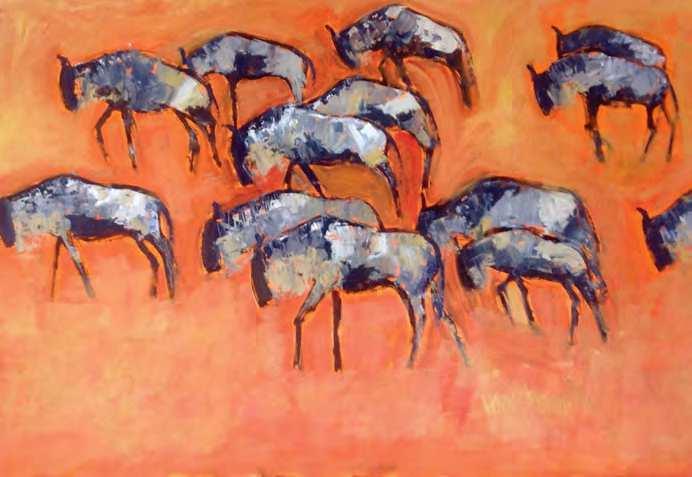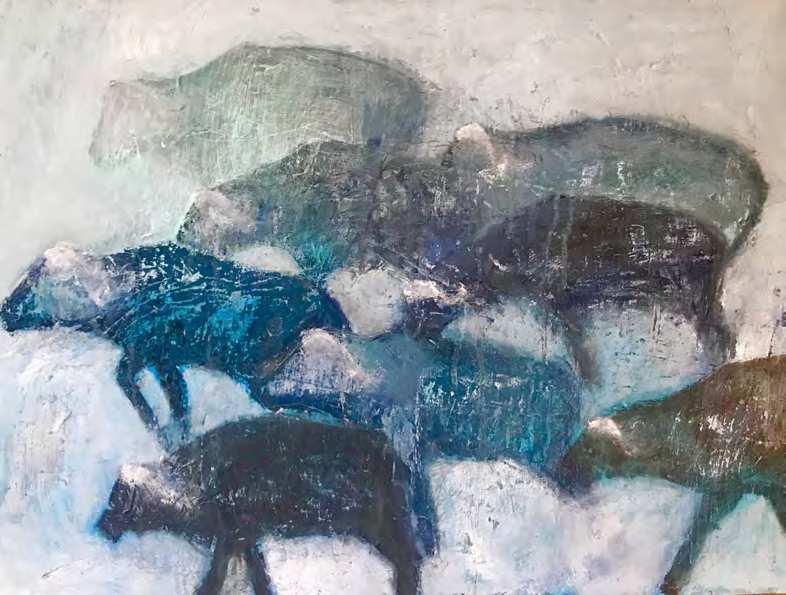
5 minute read
Bold and wild
into ideas for paintings. Most of my thinking goes on outside the studio and when I start working, I like to paint intuitively. I work on two or three paintings at a time so I don’t get wedded to one idea. Each painting informs the other and it is good to work in series. My sketchbook practice feeds the ideas for paintings. I’m always on the look-out for abstract shapes suggested by the light falling on objects or buildings. Light is changing all the time.
‘I always have ideas knocking around in my head. Some come straight out and become paintings quite quickly and others take longer. When I am working in the studio the ideas develop. The thinking goes on all the time in my life but when I’m working in the studio, I work intuitively. I don’t want to commit to an idea too early on in the process because I get better results when I push myself and get out of my comfort zone.’
Advertisement
Luminosity and depth
‘I have been working in oils for several years, but recently I’ve been working in acrylics with collage and mixed media. Acrylic paint dries quickly so it’s easy to move paintings along and not get stuck. Oil paint is buttery and has a luminosity and depth when it dries. I like painting with it on its own and I have also used it with encaustic wax, which produces beautiful, unexpected textures. The subject usually dictates the medium. I also really enjoy working in acrylics and mixed media. Red, yellow and blue with white give a good range of colours and greys. I get different results using warm or cool colours so I like to mix colours and keep colour swatches with notes so I can remember how to mix a favourite colour. The earth triad of yellow ochre, Payne’s grey and burnt sienna with white makes lots of beautiful colours.
‘I work on wood panels and canvas prepared with acrylic gesso. I then paint several layers of paint, collage and drawing usually turning the painting 90 degrees between each ‘pass’ to find unexpected compositions. I scratch into the surface and use sand paper to reveal previous layers of the painting which add interesting textures. I think it’s important to work on a painting as a whole rather than a section at a time.
‘The subject dictates the size of the painting. A favourite format for stilllife paintings is 9¾39¾in (30330cm). Larger subjects require bigger panels, but I find it difficult to work in a series if I work any larger than 39½339½in (1003100cm). The time it takes me to complete a painting varies enormously. Some almost paint themselves and come about quite quickly. Others take longer!’
Perseverance and focus
‘Without being flippant, the more you paint the better you get at knowing when a painting is finished, and when I’m working, there is definitely

p An Implausibility of Wildebeest, oil on wood panel, 233/43311/2in (60380cm). ‘When I was lucky enough to be on safari, one of our guides said that the collective noun for wildebeest is an implausibility. This really caught my imagination as a name for a painting. I love painting wildebeest as they have the most interesting shape. They are often referred to as one of the ugly five, which is unfair, I think, as they are one of my favourite animals.’
t Blue Buffalos, oil on wood panel, 233/43311/2in (60380cm). ‘On safari last summer we saw enormous herds of buffalo. When they travel en masse they stir up huge dust clouds. I tried to capture the feeling of the dust swirling around the buffalo in the early morning.’

a beginning, a middle and an end. Sometimes, when in the middle, the painting can look very ugly and it takes perseverance to push it to the finish. I think I’m lucky if three in five make it to finished paintings. I don’t expend energy on a painting that I am not happy with. I paint over and start again.
‘I’m very lucky to have a beautiful studio in our home so I can pop in and out of the studio while pretending to be a domestic goddess! I get up early as we have dogs, horses, pigs and sheep that need to be fed first thing. I walk the dogs then spend some time in the studio. We regularly ride our horses in the local woods. On days when I’m painting, I usually spend at least four hours in the studio.
‘I work with two galleries who regularly have mixed summer and Christmas exhibitions. The Russell Gallery in
p Dusk at Vista Verde, oil on canvas, 233/43233/4in (60360cm). ‘When our boys were little, we took them to Vista Verde ranch in Colorado to learn how to ride. It was a wonderful experience – living like a cowboy and riding the beautiful horses. I loved drawing them when they were in the coral at the end of the day before they were set free to graze overnight in the lush meadows. Although horses are herd animals there is a definite pecking order and it is fascinating to see how they interact with each other.’
Putney, London, also shows my work at the Affordable Art Fairs. I find the discipline of having a show to work towards gives me a goal and keeps me focused. I enter several open exhibitions and competitions every year. It’s always flattering to win prizes as it validates my work. Painting can be quite a lonely activity so it is gratifying when someone I don’t know acknowledges my efforts. It’s also a nice way to meet fellow artists. I have done some commissions in the past, but I prefer to work on my own ideas.
Colette Clegg
lives on a farm in Surrey with her husband Aidan. See more of Collette’s work on Facebook, Instagram or Twitter, or at https://coletteclegg.co.uk/










